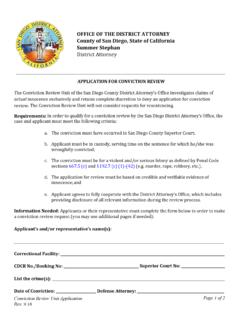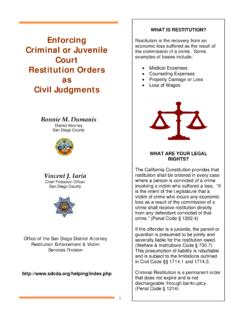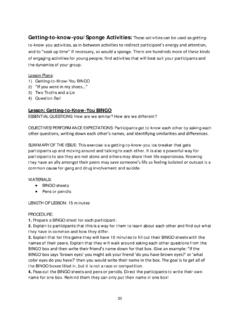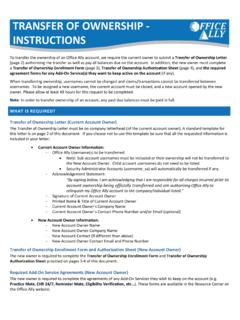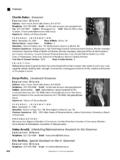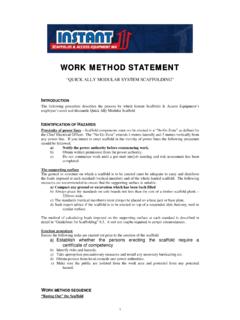Transcription of Violence - San Diego County District Attorney
1 63 Violence : Participants articulate choices and consequences related to different kinds of Violence . Lesson plans: 1) Violence 2) Cross the Line 3) Bullying 4) Gangs 5) Relationship Violence Take a Stand Lesson: Violence ESSENTIAL QUESTIONS: What is Violence ? What are the causes and effects of Violence ? How can we practice being nonviolent towards ourselves and others? How can we keep ourselves safe? OBJECTIVES/PERFORMANCE EXPECTATIONS: Participants discuss definitions and examples of types of Violence ; participants discuss consequences of Violence ; participants strategize how to avoid Violence . SUMMARY OF THE ISSUE: Violence can range from extreme physical Violence such as murder and rape to verbal or emotional abuse such as name calling and constant criticism to institutional Violence such as racism and homophobia. All types of Violence are used to exert power and control and have profound effects on personal health and well-being.
2 Girls and women are directly or indirectly affected by sexual Violence and abuse, physical Violence and abuse, and/or emotional abuse sometime in their lives. The OJJDP says, sexual assault is a risk factor for both boys and girls, but the rate of exposure to this risk factor is greater for girls (Slowikowski 3). Children, girls and boys, who grow up in communities that face poverty, widespread drug use, and gang presence are also often exposed to general community Violence . Community Violence defined by Mental Health Systems, Inc. of San Diego as frequent and continual exposure to the use of guns, knives, and drugs, and random Violence often leads to feelings of anxiety, low-self-esteem, fear, aggression, PTSD, depression, anger, distrust, alienation, betrayal, and impaired body image. These feelings often manifest as behaviors such as learning difficulties, difficulty paying attention, acting out or risk taking behaviors, suicide attempts, fighting, inappropriate sexual activities, involvement in prostitution, and involvement in drugs, making community Violence a tragically cyclical problem (Hamblen 1).
3 It is no surprise, then, that girls in the juvenile justice system have higher rates of histories of abuse than girls who are not involved in the system (Slowikowski 3), pointing to the lasting, negative effects of Violence . Much abuse of young women especially at the hands of parents or random Violence is tragically unavoidable. However, if girls are able to build 63confidence, learn to respect themselves and their bodies, and make responsible choices at a young age, some Violence against them can be prevented. Girls are increasingly becoming perpetrators of Violence themselves and must be taught healthy coping skills for anger and other emotions. It is important to teach young people that acting violent is always a choice and 64 it always has consequences. It is also important to teach young people that if they are victims of Violence , it is not their fault. MATERIALS: White board or chalk board Very Violent or Very Peaceful?
4 Statements Poster paper Pens and pencils LENGTH OF LESSON: 1 to 2 hours PROCEDURE: 1. Begin by explaining that today you will be talking about different kinds of Violence . 2. Write very violent on one end of the board and very peaceful on the other end. Draw a long line in between the two statements. Explain that you will read statements and the participants will move to whichever side they think goes with the statement. There is not a right or wrong answer and participants can stand anywhere in between the two extremes. 3. Read 5 to 10 examples and have participants move to either side or anywhere in between. Allow participants to discuss as issues come up. Prompt them with questions: Why do you think that is very violent? Why are you not sure? Why do you think that is very peaceful? Does it depend on the situation? Do you need more information? Why would someone act that way?
5 Very Violent or Very Peaceful? A boy hits a girl A girl hits a boy You get spanked Your friend gives you a hug when you feel sad A family lives in poverty Parents yelling at each other Someone spreads a rumor about you Someone calls you stupid The teacher tells the whole class you got an F on your test Someone kisses you when you don t want them to Your mentor helps you with your homework Someone touches your hair after you have asked them not to A friend shares their lunch with you Your brother steals all the money you ve saved in your piggy bank Your brother calls you fat A boy shows you his butt and it makes you feel uncomfortable Murder Your mom tells you she will leave you unless you behave Someone you don t know follows you home every day A group of girls give you the silent treatment Your sister breaks your favorite necklace Someone
6 Threatens to choke you if you don t let them cheat off your homework Your brother or sister locks you in the closet 65 You lock the dog out of the house without dinner Your friend gives you a birthday present Your teacher tells you that you aren t going to succeed You wish your friend good luck at their basketball game 4. After discussing 5 to 10 circumstances, have participants return to their seats. 5. Explain that there are many different types of Violence . Physical Violence occurs when someone uses their body or a weapon to hurt your body. Verbal or emotional abuse occurs when someone uses words (written or said out loud) to hurt your feelings or scare you. Sexual Violence occurs when someone makes you do some kind of sexual activity when you don t want to. Neglect is when someone who is supposed to be taking care of you does not take care of you.
7 Institutional Violence occurs when organizations or institutions discriminate against a group of people because of their skin color, gender, or how much money they have. All of these kinds of Violence affect our health in many ways. 6. Explain that participants will make a poster showing different kinds of Violence , the consequences of the Violence , and how to challenge the Violence . 7. Divide participants into pairs or small groups. Pass out poster paper, pens, and pencils. 8. Direct participants to draw a picture of at least three different examples of Violence . They can use words too. For each example of Violence (ex: 1) teasing, 2) pushing, 3) silent treatment) they should draw a representation of the consequences of that Violence (ex: 1) hurt feelings, 2) broken arm, 3) hurt feelings), and what can be done to challenge that Violence (ex: 1) tell them how it makes you feel, 2) run away, 3) tell a teacher or counselor).
8 9. Have participants share their posters and ideas for avoiding Violence . 10. Remind participants you are there to talk to in case they ever experience Violence or need help avoiding Violence . JOURNAL PROMPT: Do you think Violence is ever necessary? When do you think Violence is necessary? Have you experienced or seen Violence ? Have you challenged or seen a challenge to Violence ? EVALUATION: Did participants describe different types of Violence ? Did participants discuss consequences of Violence ? Did participants create a poster depicting different types of Violence ? Did participants strategize ways to avoid Violence ? RELATED ACTIVITIES: Invite an age-appropriate survivor of domestic Violence , sexual Violence , torture, or other Violence to speak to Girls Only about their experience. Have participants create and sign a nonviolence pact, vowing to be non-violent and challenge Violence in their lives.
9 66 Lesson: Cross the Line ESSENTIAL QUESTIONS: How are we similar? How are we different? OBJECTIVES/PERFORMANCE EXPECTATIONS: Students build empathy by learning about other s life experiences; students feel less alone in their life experiences. SUMMARY OF THE ISSUE: This exercise is a visually powerful way for participants to see they are not alone and that others may share their life experiences. Knowing they have an ally amongst their peers may save someone s life as feeling isolated or outcast is a common cause for gang and drug involvement and suicide. MATERIALS: Cross the line questions Tape or string to make a line on the floor LENGTH OF LESSON: 60-90 minutes PROCEDURE: 1. Create a line on the floor. 2. Have all participants stand on one side of the line. 3. Explain that you will read a question starting with, Cross the line and that if it applies to them, they should step to the other side of the line.
10 Remind the students to be as honest as they are comfortable with and that the space is non-judgmental and safe. Explain there should be no talking during the game, except for the person asking the question and that there will be a discussion afterwards. Ask if there are any questions. 4. Begin the game. Read a question beginning with, Cross the line (you have brown hair; you have blue eyes; you have a brother). Participants step across the line if it applies to them and remain on the starting side of the line if it does not. Pause and ask the students to silently look around to see who is standing with them. Then ask them to go back to the starting side of the line. 5. The following is a list of sample questions. The questions should be tailored to the needs of the age and populations you are working with. Cross the line You have brown hair. Your favorite color is purple You have a sister.
